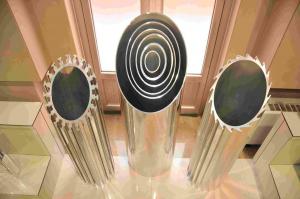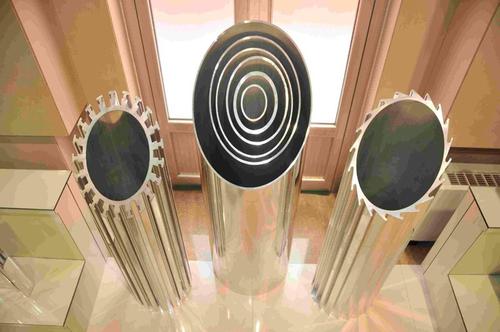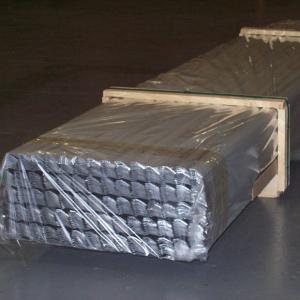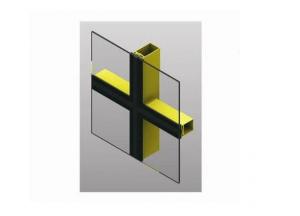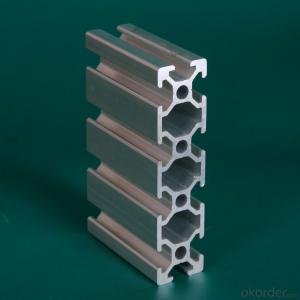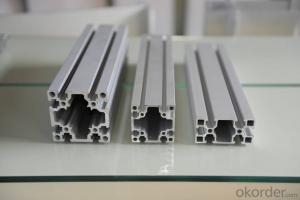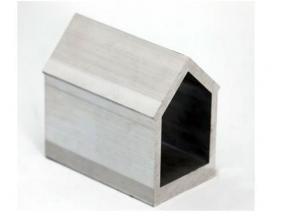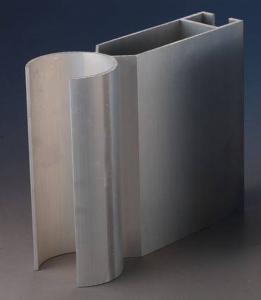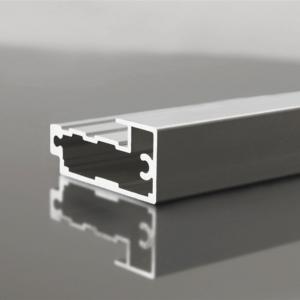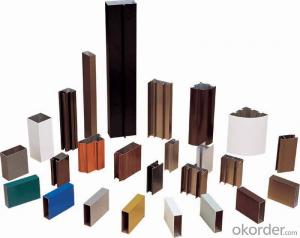Aluminum extrusion profile for machine, building, industry field
- Loading Port:
- China Main Port
- Payment Terms:
- TT OR LC
- Min Order Qty:
- -
- Supply Capability:
- -
OKorder Service Pledge
OKorder Financial Service
You Might Also Like
Aluminum extrusion profile for machine, building, industry field
1. Usage:Aluminum Large Cross Sections
2. Surface:mill
3. Alloy:6063T5
4. Size:according to customer’s requirement
5. Advantage:Durability, good corrosion resistance and lightweight
6. Package Normal paper package and soft plastic interleaving each profile to protect the surface. In case of any special package, additional packing cost will be charged.
Specifications: offer competitive and high quality all sizes and types of aluminium profiles in mill, anodized, painted finishes
Applications:
Industry Aluminum profile used in cars, trains machinery ,electronics, medical and other industrial filed . In terms of hardware, machinery, electromechanical parts, solar PV products, aluminum frames are adopt as important auxiliary materials. We also have aluminum profiles for radiators, fitness machinery, buildings, lighting instrument, windpipes, oil pipelines, etc.
- Q: This question asks for a list of various uses of aluminum profiles within the construction industry.
- <p>Aluminum profiles have a wide range of applications in the construction industry due to their strength, durability, and lightweight properties. They are used in window and door frames for their resistance to corrosion and ease of maintenance. They are also employed in curtain walls, which are the outer coverings of buildings, providing both aesthetic appeal and structural integrity. Aluminum profiles are utilized in the construction of scaffolding for their high strength-to-weight ratio, ensuring safety and stability. Additionally, they are used in the manufacturing of modular buildings and prefabricated structures due to their ease of assembly and disassembly. Other applications include roofing systems, flooring structures, and as support beams in various construction projects.</p>
- Q: Do aluminum profiles have good thermal insulation properties?
- No, aluminum profiles do not have good thermal insulation properties.
- Q: What are the aluminum packaging methods?
- Common1 each cotton covered cotton;2 each sleeve;3 coat big bag plastic sealing;4, two wire line;5, three, wrapping paper;6, outsourcing cotton (outsourcing paper).....
- Q: This question asks about the various types of adhesives that can be used for bonding aluminum profiles to the frames of buildings.
- <p>There are several types of adhesives used to attach aluminum profiles to building frames, including epoxy resins, polyurethane adhesives, and silicone sealants. Epoxy resins are known for their high strength and resistance to chemicals and temperature changes. Polyurethane adhesives offer flexibility and are good for bonding different materials. Silicone sealants are used for their weather resistance and flexibility, making them suitable for exterior applications. Each type of adhesive has specific properties that make it suitable for different applications and environmental conditions.</p>
- Q: How do aluminum profiles perform in vibration isolation applications?
- Aluminum profiles are commonly used in vibration isolation applications due to their excellent mechanical properties. They exhibit high stiffness, durability, and damping characteristics, which help in effectively reducing vibrations. Additionally, their lightweight nature allows for easy installation and portability. Overall, aluminum profiles perform well in vibration isolation applications, providing reliable and efficient solutions.
- Q: Are aluminum profiles suitable for outdoor use and can they withstand weathering?
- <p>Yes, aluminum profiles can be used for outdoor applications. They are resistant to corrosion and weathering due to their inherent properties and can be anodized or powder coated for additional protection against the elements. This makes them suitable for a variety of outdoor uses such as construction, furniture, and signage. However, it's important to ensure that the profiles are properly finished and maintained to prolong their lifespan and performance outdoors.</p>
- Q: Is it possible to incorporate recycled aluminum extrusions into a construction project?
- <p>Yes, you can use recycled aluminum extrusions in your building project. Recycled aluminum is not only environmentally friendly but also offers the same strength and durability as new aluminum. It is commonly used in construction for framing, window and door profiles, and structural components. Ensure that the recycled aluminum meets the required industry standards for your project to guarantee quality and performance.</p>
- Q: This question asks about the various types of aluminum profiles that are utilized in the construction of exterior wall systems.
- <p>Aluminum profiles for exterior wall systems include several types: 1. <strong>Vertical and Horizontal Mullions</strong>: These are the main structural components that form the framework of the system. 2. <strong>Transoms and Muntins</strong>: These profiles divide the large glass panes into smaller sections, providing structural support and aesthetic appeal. 3. <strong>Cover Caps</strong>: Used to cover the joints and intersections of the profiles, enhancing the visual appearance and weatherproofing. 4. <strong>Sill Channels</strong>: Installed at the base of windows to direct water away from the building. 5. <strong>Head Channels</strong>: Positioned at the top of the window or door openings. 6. <strong>Jamb Liners</strong>: These are used to reinforce the sides of the openings. 7. <strong>Gaskets and Seals</strong>: Essential for weatherproofing and insulation. Each type serves a specific function in ensuring the stability, durability, and aesthetic of the exterior wall system.</p>
- Q: Are aluminum profiles suitable for use in furniture fittings and accessories?
- Yes, aluminum profiles are suitable for use in furniture fittings and accessories. Aluminum is lightweight, durable, and resistant to corrosion, making it an ideal material for various furniture applications. Additionally, aluminum profiles can be easily fabricated into different shapes and designs, allowing for versatility in furniture design.
- Q: Can aluminum profiles be an alternative to wood in construction?
- Yes, aluminum profiles can be a viable alternative to wood in construction. Aluminum profiles offer several advantages over wood, making them a popular choice in many construction projects. Firstly, aluminum profiles are lightweight yet strong, allowing for easy handling and installation. This characteristic makes them suitable for various applications, including frames for doors, windows, curtain walls, and partitions. Additionally, aluminum profiles have excellent durability and resistance to weathering, corrosion, and pests, making them a long-lasting and low-maintenance option. Furthermore, aluminum profiles have inherent fire-resistant properties, which can enhance safety in construction. Unlike wood, aluminum does not burn, and it has a high melting point, making it less likely to contribute to the spread of fires. In terms of sustainability, aluminum profiles can offer environmental benefits. Aluminum is a highly recyclable material, meaning that it can be reused and repurposed multiple times without losing its properties. This recyclability reduces the environmental impact associated with construction projects and supports the circular economy. Another advantage of using aluminum profiles is their design versatility. Aluminum can be easily shaped and extruded into various profiles and sizes, allowing for customization and flexibility in architectural designs. This adaptability makes aluminum profiles suitable for both functional and aesthetic purposes in construction. However, it is important to note that aluminum profiles may have higher upfront costs compared to wood. Additionally, the thermal conductivity of aluminum is higher than that of wood, which means that aluminum profiles may require additional insulation to provide optimal thermal performance. In conclusion, aluminum profiles can be a viable alternative to wood in construction due to their lightweight, durability, fire resistance, sustainability, and design versatility. While there may be some considerations regarding cost and thermal conductivity, the benefits of aluminum profiles make them an attractive option for various construction applications.
Send your message to us
Aluminum extrusion profile for machine, building, industry field
- Loading Port:
- China Main Port
- Payment Terms:
- TT OR LC
- Min Order Qty:
- -
- Supply Capability:
- -
OKorder Service Pledge
OKorder Financial Service
Similar products
Hot products
Hot Searches
Related keywords
